
Lithuania, officially the Republic of Lithuania, is a country in the Baltic region of Europe. Lithuania is considered to be one of the Baltic states. The country is situated along the southeastern shore of the Baltic Sea, to the east of Sweden and Denmark. It is bordered by Latvia to the north, Belarus to the east and south, Poland to the south, and Kaliningrad Oblast to the southwest. Lithuania has an estimated population of 2.8 million people as of 2019, and its capital and largest city is Vilnius. Other major cities are Kaunas and Klaipėda. Lithuanians are Baltic people. The official language, Lithuanian, is one of only two living languages in the Baltic branch of the Indo-European language family, the other being Latvian.
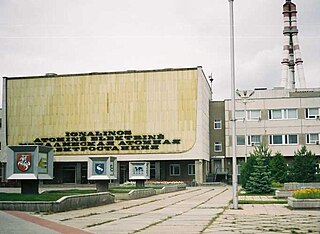
The Ignalina Nuclear Power Plant is a decommissioned two-unit RBMK-1500 nuclear power station in Visaginas Municipality, Lithuania. It was named after the nearby city of Ignalina. Due to the plant's similarities to the infamous Chernobyl Nuclear Power Plant in both reactor design and lack of a robust containment building, Lithuania agreed to close the plant as part of its accession agreement to the European Union. Unit 1 was closed in December 2004; Unit 2, which counted for 25% of Lithuania's electricity generating capacity and supplied about 70% of Lithuania's electrical demand, was closed on December 31, 2009. Proposals have been made to construct a new nuclear power plant at the same site. However, plans have not materialised since then, and the country is one of the most active supporters of renewable energy.

Rietavas is a city in Lithuania on the Jūra River. According to the 2001 census it had a population of 3,979. It is the capital of Rietavas municipality.

Renewable energy plays an important and growing role in the energy system of the European Union. The share of energy from renewable sources in gross final consumption of energy was 17% in 2016. This is double the share in 2004 with 8.5%. The Europe 2020 strategy includes a target of reaching 20% of gross final energy consumption from renewable sources by 2020, and at least 27% by 2030. These figures are based on energy use in all its forms across all three main sectors, the heating and cooling sector, the electricity sector and the transport sector.
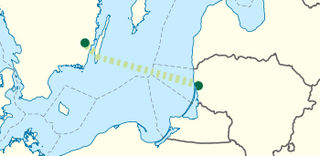
NordBalt is a submarine power cable between Klaipėda in Lithuania and Nybro in Sweden. The purpose of the cable is to facilitate the trading of power between the Baltic and Nordic electricity markets, and to increase the supply and energy security in both markets.
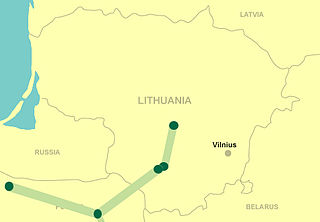
The Lithuania–Poland interconnection LitPol Link represents electricity link between the Baltic transmission system and the synchronous grid of Continental Europe. As of 2016 the first stage of the project which has a capacity of 500 MW has been completed.

As of December 2017, installed capacity of wind power in the European Union totaled 169.3 gigawatts (GW). In 2017, a total of 15,680 MW of wind power was installed, representing 55% of all new power capacity, and the wind power generated 336 TWh of electricity, enough to supply 11.6% of the EU's electricity consumption.
The Kaliningrad Nuclear Power Plant is a nuclear power plant under construction 13 kilometres (8.1 mi) south-east of Neman, in Kaliningrad Oblast, Russia. It is seen as a counter-project to the plan to build the Visaginas nuclear power plant in Lithuania and is considered not only as an energy, but also as a geopolitical project. In June 2013 the construction was temporary stopped for the project to be redesigned.
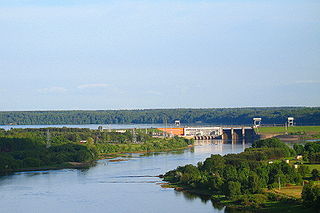
The Kaunas Hydroelectric Power Plant, located on the Nemunas River about 7.4 kilometres (4.6 mi) southeast of central Kaunas, Lithuania, was completed in 1960. Its dam created the Kaunas Reservoir. Owned by Lietuvos Energija, it operates in conjunction with the Kruonis Pumped Storage Plant.

Nord Pool AS is a European power exchange owned by Euronext and the continental Nordic and Baltic countries' Transmission system operators (TSOs). Nord Pool delivers power trading across Europe. Nord Pool offers day-ahead and intraday trading, clearing and settlement, data and compliance, as well as consultancy services. More than 360 customers trade on Nord Pool today.
Lithuania does not have any operational nuclear power reactor. It operated two RBMK reactors at Ignalina nuclear power plant which were shut down in 2004 and 2009.
Poland has no nuclear power plants. In the 1980s, the Zarnowiec Nuclear Power Plant was under construction, but was abandoned on 4 September 1990. To this day, nuclear energy is a controversial topic in Poland.
Lithuania is a net energy importer. Primary energy use in Lithuania was 98 TWh, or 29 TWh per million people in 2009.
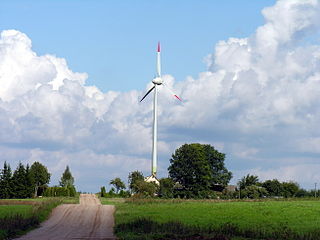
Wind power in Lithuania is a form of renewable energy in Lithuania. At the end of 2011, wind power capacity in Lithuania was 179 MW and the wind energy share of total electricity consumption was 3,8%. At the end of 2018, wind power capacity in Lithuania was 521 MW and the wind energy share of total electricity consumption was 12%.

Solar power in Lithuania is a form of renewable energy in Lithuania, and created 39 GWh of electricity in the first nine months of 2013.

In 2016 Renewable energy in Lithuania constituted 27.9% of the country's overall electricity generation. Previously, the Lithuanian government aimed to generate 23% of total power from renewable resources by 2020, a goal was achieved in 2014 (23.9).

Litgrid is a transmission system operator in located in Vilnius, Lithuania. It is a subsidiary of EPSO-G AB, which owns 97.5% of its shares.
Lithuanian Electricity Association was established on 5 June 1998.

Energijos Skirstymo Operatorius AB (ESO) is an electricity and gas distribution company in Lithuania. It was established on 1 January 2016 through merger of the Lithuanian electricity distribution network operator LESTO AB and a gas company Lietuvos dujos. ESO is controlled by a state-owned group of energy companies Lietuvos Energija which owns 94.98% of shares. Its shares are traded on NASDAQ OMX Vilnius.
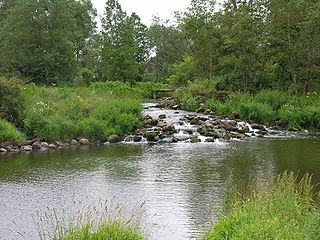
Varduva is a river in northwestern Lithuania. Its length is 90.3 kilometres (56.1 mi). It is a left tributary of Venta; their confluence is on the Lithuania–Latvia border. Its origins and upper reaches are located within the Žemaitija National Park. Its largest tributary is Sruoja. Larger settlements situated near Varduva include Žemaičių Kalvarija, Seda, Renavas, Ukrinai. Varduva has five small hydroelectric power plants: Kulšėnai, Ukrinai, Vadagiai, Juodeikiai, Renavas. The largest of these plants in Juodeikiai produced 2.99 GWh of electricity in 2010.














